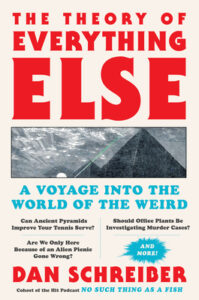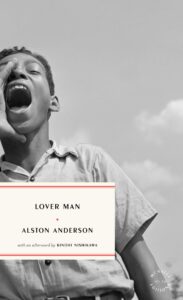
Our basket of brilliant reviews this week includes Fintan O’Toole on Mark O’Connell’s A Thread of Violence, Idra Novey on Domenico Starnone’s The House on Via Gemito, Ginny Hogan on Josh Hawley’s Manhood, Dan Pipenbring on Dan Schreiber’s The Theory of Everything Else, and Darryl Pinckney on Alston Anderson’s Lover Man.
“[O’Connell] comes to the story, essentially, through the veil of fiction. He did a PhD on Banville and it was via The Book of Evidence that he became fascinated by the man whom the novelist had transformed into Montgomery. With other violent events, this might be a terrible place to start. It suggests a dreadful essay in postmodern cleverness, where there is no distinction between what happened and how it is represented, and morality is an embarrassing anachronism. But nothing could be further from O’Connell’s intent; in this weird case, the impulse to explore and unravel fictions is just the right instinct. It gives O’Connell, when he tracks down Macarthur (who has been around Dublin since his release from prison in 2012) and gets him to tell his own story, a heightened awareness that it is indeed precisely that: yet another story, another linguistic construct in which the relationship between truth and fiction is murky, unstable and impossible to pin down with any certainty … O’Connell is acutely conscious of the moral ambiguity of giving a voice to a man who does not really take responsibility for his vile acts but rather, as O’Connell puts it, accepts that he committed murder but does not accept that he is a murderer … This is what makes A Thread of Violence such a remarkable book. If it begins in the genre of ‘true crime’—let’s find the murderer and see if he will tell us what happened—it becomes an exploration of the human capacity to avoid truth … the book itself is haunting in its dissection of the mechanisms that allow human beings to dehumanize others.”
–Fintan O’Toole on Mark O’Connell’s A Thread of Violence: A Story of Truth, Invention, and Murder (The Irish Times)
“Starnone is a writer exquisitely attuned to class anxieties: As his later novels do, Via Gemito explores the emotional cost of class mobility, and the psychic toll of changing one’s speech patterns and behavior for the sake of social and financial gain … Nowhere is the emotional toll of his shapeshifting more clearly on display than in a scene from Mimí’s adolescence, when he begins to try on different voices and behaviors, and adopt the mannerisms of relatives and strangers. One day, he arrives at church wearing a tunic his mother has cut as short as a girl’s dress. There, he ends up performing the female part in a dance with a classmate, a muddling of gender roles that leaves him feeling so humiliated that he begins to see himself not as a physical form, but as ‘an intimate sigh, a moan.’ Shame, this scene suggests, is a powerful psychic trap, and the only reliable way out is through acts of imagination. It’s a stirring memory for an adult male narrator to share, one that stayed with me as vividly as the wary gaze of the Neapolitan mastiff that Federí paints after dark, with its large muzzle and piercing eyes.”
–Idra Novey on Domenico Starnone’s The House on Via Gemito (The Atlantic)
“Josh Hawley, best known for fleeing a mob he helped incite, has written a book on manhood. In Hawley’s defense, he began writing the book before everyone found out about the running-away situation. But it was, unfortunately, after he did the running … To be honest, I’m not sure I can imagine a less productive message than encouraging men to become fathers before they’re ready. Hawley is only interested in helping men live the exact same life that he himself leads, even if that life isn’t available (or even desirable) to them. According to recent studies, it turns out that a slight majority of Americans did not attend Yale Law School or receive campaign donations from Peter Thiel. No one, myself included, should read this book … A consistent through line in Manhood is Hawley’s unsettling obsession with restraint. He clearly takes pride in his own body, evidenced by the inclusion of a gratuitous story about strangers asking him if he were an athlete. The only thing he apologizes for—in the entire book—is letting his kids eat doughnuts once a week. In villainizing the Epicurean left, he argues that self-control is the solution … I started this review by making fun of Hawley for running away from the January 6 insurrectionists. And we should never stop making fun of that. But we can’t let it be the only thing people know about him. Running from danger isn’t the worst thing he’s ever done, and I’m not sure who would have benefited if Hawley had stood his ground and started swinging fists at the rioters at the Capitol. It’s what he did before and after that. There are many different ways to be a man, but the type we need is someone who takes responsibility for his actions. Here are Hawley’s actions: All he’s done, for his entire career, is pin the blame on anyone but himself. By that standard of manhood alone, I feel comfortable saying Hawley’s not one.”
–Ginny Hogan on Josh Hawley’s Manhood: The Masculine Virtues America Needs (The Nation)

“The rise of the search engine, reference text ad infinitum, spelled doom for many books such as these. So it’s a pleasure to encounter Dan Schreiber’s The Theory of Everything Else: A Voyage Into the World of the Weird, a willfully miscellaneous survey of the bizarre beliefs that people have held over the centuries: the kind of random, strange-for-the-sake-of-strange compendium that’s seldom published anymore. Here, united in a single volume, are hollow-Earthers, plant-talkers and Satanists; here is the inventor of a bean that causes less flatulence; here is ‘the world’s first pubic louse hunter.’ The Theory of Everything Else isn’t quite a reference text—it lacks so much as an index—but its aimless esoterica makes it feel like one. I mean that as a compliment. I can imagine needing to consult this book in the middle of the night, though I can’t imagine why … By now you can see that The Theory of Everything Else is all over the map. Its broadness is mainly an asset—it makes the book suitable for beach reading or for mainlining before a dinner party. Schreiber brings a formidable amount of research to bear, and he’s careful never to mock any of his subjects, even those who may deserve it. But he’s sometimes too adept at quarantining the weirdness, too certain of where the rational ends and the irrational begins. Readers who feel that it’s possible, even beneficial, to believe something and disbelieve it at the same time will wish that he had more to say about his own attraction to Chiroptera. Knocking around somewhere amid his skepticism is a head-spinning story about the nature of belief: about how simple it is to pick up or abandon the ideas that dictate our basic orientation toward the world.”
–Dan Pipenbring on Dan Schreiber’s The Theory of Everything Else: A Voyage Into the World of the Weird (The New York Times Book Review)

“Black talk is again on the move in Lover Man, a newly reissued collection of melancholy stories by Alston Anderson originally published in 1959. Alston Anderson is one of those lost names of twentieth-century African American literature. In our present cultural mood of generous reexamination, the hunt is on for the forgotten, the overlooked, the could have been, and there among them is Anderson … It took Anderson a while to get Lover Man together—a much-praised literary takeoff. However, his was the brief flight of a self-destructive soul, and before long his name had sunk in the darkness … While Ellison’s presence is on every page of Invisible Man, Anderson in Lover Man heads in the other direction, as if already in pursuit of his own disappearance … Anderson begins somewhere in the Black Belt, in the 1930s of people having to chop wood for the kitchen stove. His style is straightforward, but the simplicity is deceptive, the calm surface at odds with the depths sending up their clues … Writers are not dialectologists. The sound of Anderson’s Deep South is a work of the imagination. He came from the Canal Zone to the Upper South, not the Black Belt, but his ear, like Hurston’s, can be faultless. An Anderson story can be in the form of a lie, and then within that lie he has a character tell a lie. Folklore as language is a collective experience, a symbol of identity, a dialect maintained by common experiences. Yet although most of Anderson’s stories are set in the South, Lover Man has considerable interest as a portrait of black postwar migration from the lusty, incestuous-feeling, small-town South to the war-changed streets of Harlem, where there is bebop and heroin and a boxer answering the door in his underwear who is maybe also rough trade.”
–Darryl Pinckney on Alston Anderson’s Lover Man (The New York Review of Books)

